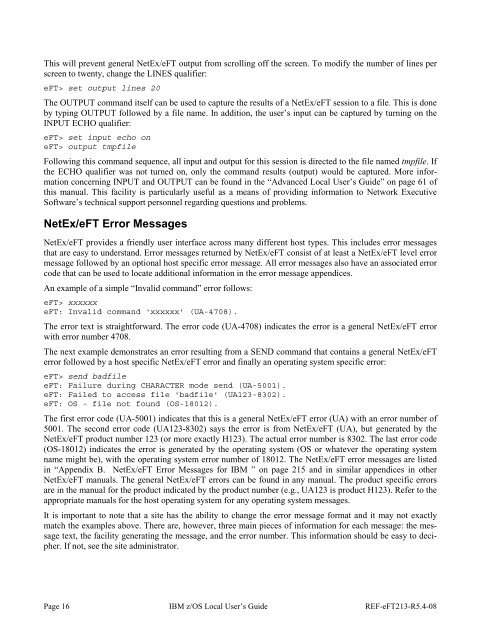NetEx EFT213 Reference Manual Rel 5.4
NetEx EFT213 Reference Manual Rel 5.4
NetEx EFT213 Reference Manual Rel 5.4
Create successful ePaper yourself
Turn your PDF publications into a flip-book with our unique Google optimized e-Paper software.
This will prevent general <strong>NetEx</strong>/eFT output from scrolling off the screen. To modify the number of lines perscreen to twenty, change the LINES qualifier:eFT> set output lines 20The OUTPUT command itself can be used to capture the results of a <strong>NetEx</strong>/eFT session to a file. This is doneby typing OUTPUT followed by a file name. In addition, the user’s input can be captured by turning on theINPUT ECHO qualifier:eFT> set input echo oneFT> output tmpfileFollowing this command sequence, all input and output for this session is directed to the file named tmpfile. Ifthe ECHO qualifier was not turned on, only the command results (output) would be captured. More informationconcerning INPUT and OUTPUT can be found in the “Advanced Local User’s Guide” on page 61 ofthis manual. This facility is particularly useful as a means of providing information to Network ExecutiveSoftware’s technical support personnel regarding questions and problems.<strong>NetEx</strong>/eFT Error Messages<strong>NetEx</strong>/eFT provides a friendly user interface across many different host types. This includes error messagesthat are easy to understand. Error messages returned by <strong>NetEx</strong>/eFT consist of at least a <strong>NetEx</strong>/eFT level errormessage followed by an optional host specific error message. All error messages also have an associated errorcode that can be used to locate additional information in the error message appendices.An example of a simple “Invalid command” error follows:eFT> xxxxxxeFT: Invalid command ‘xxxxxx’ (UA-4708).The error text is straightforward. The error code (UA-4708) indicates the error is a general <strong>NetEx</strong>/eFT errorwith error number 4708.The next example demonstrates an error resulting from a SEND command that contains a general <strong>NetEx</strong>/eFTerror followed by a host specific <strong>NetEx</strong>/eFT error and finally an operating system specific error:eFT> send badfileeFT: Failure during CHARACTER mode send (UA-5001).eFT: Failed to access file 'badfile' (UA123-8302).eFT: OS - file not found (OS-18012).The first error code (UA-5001) indicates that this is a general <strong>NetEx</strong>/eFT error (UA) with an error number of5001. The second error code (UA123-8302) says the error is from <strong>NetEx</strong>/eFT (UA), but generated by the<strong>NetEx</strong>/eFT product number 123 (or more exactly H123). The actual error number is 8302. The last error code(OS-18012) indicates the error is generated by the operating system (OS or whatever the operating systemname might be), with the operating system error number of 18012. The <strong>NetEx</strong>/eFT error messages are listedin “Appendix B. <strong>NetEx</strong>/eFT Error Messages for IBM ” on page 215 and in similar appendices in other<strong>NetEx</strong>/eFT manuals. The general <strong>NetEx</strong>/eFT errors can be found in any manual. The product specific errorsare in the manual for the product indicated by the product number (e.g., UA123 is product H123). Refer to theappropriate manuals for the host operating system for any operating system messages.It is important to note that a site has the ability to change the error message format and it may not exactlymatch the examples above. There are, however, three main pieces of information for each message: the messagetext, the facility generating the message, and the error number. This information should be easy to decipher.If not, see the site administrator.Page 16 IBM z/OS Local User’s Guide REF-eFT213-R<strong>5.4</strong>-08















